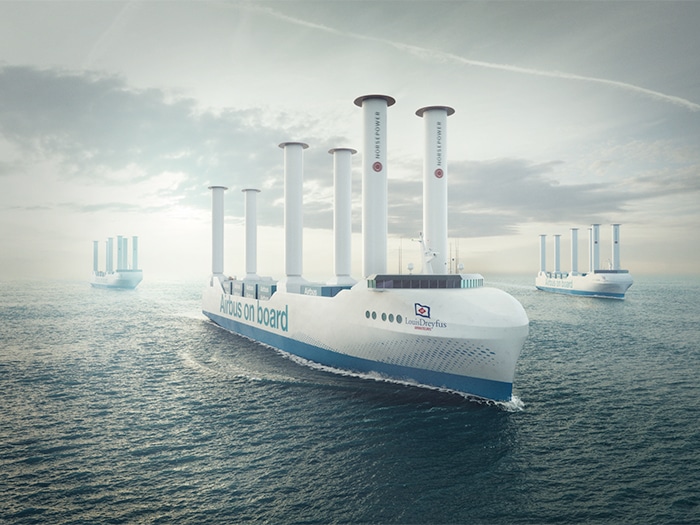
LDA Airbus ships will feature Berg hybrid propulsion system
Written by Nick Blenkey
Image: LDA
Berg Propulsion has won a contract covering the hybrid propulsion solution that will ensure that three wind-assisted Louis Dreyfus Armateurs (LDA) RO/RO vessels maximize efficiency regardless of their mode of operation.
The vessels are being built for charter to Airbus and will transport aircraft subassemblies between Saint-Nazaire, France, and its single-aisle aircraft final assembly line in Mobile, Ala. Set to enter service in 2026, each will be fitted with six Norsepower rotor sails and two dual-fuel engines operating on diesel fuel and e-methanol. The percentage of e-methanol used will be stepped up in line with the availability of the green fuel.
Wind power drawn from the rotor sails will make a strong contribution to reduced emissions, with weather routing optimization software also in place to maximize wind-assisted time and minimize drag. In conventional mode, the ships will run on dual fuel methanol engines.
Optimizing propulsion performance at all times will rely on integrated power management and propulsion systems from Berg. As well as the complete propulsion train to work with each ship’s main engines, Berg is supplying state-of-the-art controllable pitch propellers with feathering capability.
“At LDA, our ambition is to lead the maritime industry through its energy transition,” said Arthur Barret, head of the engineering, project and innovation department at LDA. “We must ensure that the solutions supporting our vision are the smartest available and that we can rely on our technology partners throughout a ship’s lifetime. Berg’s integrated propulsion system enables us to minimize fuel consumption and emissions.”
According to Berg Propulsion account manager Amrita Singh, the Berg hybrid solution allows main engines and electric motors to drive propulsion either independently or simultaneously so that the most efficient power option is used as a vessel’s operational needs change.
“The system works with alternative power sources, including wind,” said Singh. “It’s key when integrating sails that they work seamlessly with propulsion controls so that adjustments can be made to thrust in any given weather and sea condition. In Berg’s solution, Dynamic Drive is integrated into the MPC800 control system, which delivers this capability without the operational complexity of additional hardware.”
Dynamic Drive is an adaptive thrust and fuel optimization software, offered for inclusion with the Berg Propulsion MPC 800 control system. The software automatically and dynamically identifies the most energy efficient settings for propeller pitch/RPM to produce the thrust to maintain the required speed.
“The propulsion package includes a range of ‘modes’, whose selection optimizes performance across the ship’s various operational requirements,” said Mattias Dombrowe, business manager – electrical system integration, at Berg Propulsion. “As well as mechanical with PTO or electric modes, propellers also operate in boost mode to achieve full speed when required. When the rotor sails are in service, one or both of the propellers can be feathered to optimize wind-assisted operations.”
Crew continuously optimize efficiency using the flexibility available to the propulsion control unit, rather than being limited by the predetermined relationships between engine load and specific fuel oil consumption, Dombrowe added.
Integration had also been a feature of the way Berg teams worked with CSSC shipyard Wuchang Shipbuilding, which is building the ships, to satisfy owner expectations, according to Wei Jun Zhang, manager at Berg Shanghai.
“Working alongside Wuchang Shipbuilding has been an absolute pleasure, allowing us to showcase the competency, capacity, and capabilities that Berg has to maximize the performance of these innovative ships,” he said,




